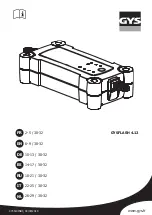
YH4
GRAND
VITARA
7B1-22
AUTOMATIC TRANSMISSION (4 A / T)
1. CUSTOMER COMPLAINT ANALYSIS
Record details of the problem (failure, complaint) and how it occurred as described by the customer.
For this purpose, use of such a inspection form will facilitate collecting information to the point required for proper
analysis and diagnosis.
2. DIAGNOSTIC TROUBLE CODE (DTC)/FREEZE FRAME DATA CHECK, RECORD AND CLEARANCE
First, referring to DTC check section, check DTC (including pending DTC). If DTC exists, print or write down
DTC and freeze frame data and then clear them by referring to DTC clearance section. DTC indicates malfunc-
tion in the system but it is not possible to know from it whether the malfunction is occurring now or it occurred
in the past and normal condition has been restored. In order to know that, check symptom in question according
to Step 5 and then recheck DTC according to Step 6.
Diagnosing a trouble based on the DTC in this step only or failure to clear the DTC in this step may result in
an faulty diagnosis, trouble diagnosis of a normal circuit or difficulty in troubleshooting which is otherwise unnec-
essary.
3 and 4. VISUAL INSPECTION
As a preliminary step, be sure to perform visual check of the items that support proper function of the A / T and
engine referring to Visual Inspection section.
5. TROUBLE SYMPTOM CONFIRMATION
Check trouble symptoms based on information obtained in Step 1 “CUSTOMER COMPLAINT ANALYSIS” and
Step 2 “DTC/FREEZE FRAME DATA CHECK”.
Also, recheck DTC according to “DTC Confirmation Procedure” described in each “DTC FLOW TABLE”.
6 and 7. RECHECKING AND RECORD OF DTC/FREEZE FRAME DATA
Refer to “DTC Check” section for checking procedure.
8. A/T BASIC CHECK AND TROUBLE DIAGNOSIS TABLE
Perform A / T basic check according to the “A / T Basic Check Flow Table” first. When the end of the flow table
has been reached, check the parts of the system suspected as a possible cause referring to TROUBLE DIAG-
NOSIS TABLE and based on symptoms appearing on the vehicle (symptoms obtained through steps of custom-
er complaint analysis, trouble symptom confirmation and/or A / T basic check) and repair or replace faulty parts,
if any.
9. DIAGNOSTIC TROUBLE CODE FLOW TABLE
Based on the DTC indicated in Step 6 and 7 and referring to “DIAGNOSTIC TROUBLE CODE FLOW TABLE”
in this section, locate the cause of the trouble, namely in a sensor, switch, wire harness, connector, actuator,
PCM or other part and repair or replace faulty parts.
10. CHECK FOR INTERMITTENT PROBLEM
Check parts where an intermittent trouble is easy to occur (e.g., wire harness, connector, etc.), referring to
“INTERMITTENT AND POOR CONNECTION” in Section 0A and related circuit of DTC recorded in Step 2.
11. FINAL CONFIRMATION TEST
Confirm that the problem symptom has gone and the A / T is free from any abnormal conditions.
If what has been repaired is related to the malfunction DTC, clear the DTC once, set conditions under which
DTC was detected and A / T and/or vehicle was repaired and confirm that no DTC is indicated.
Summary of Contents for Grand Vitara 1998
Page 225: ...YH4 GRAND VITARA FRONT SUSPENSION 3D 23 TIGHTENING TORQUE SPECIFICATIONS ...
Page 531: ...YH4 GRAND VITARA 8 6 BODY ELECTRICAL SYSTEM POWER SUPPLY DIAGRAM Refer to Section 8A ...
Page 659: ...YH4 GRAND VITARA BODY SERVICE 9 41 1 Side body outer panel A Apply sealant B Brush treatment ...
Page 673: ...YH4 GRAND VITARA BODY SERVICE 9 55 B B C C 2 DOOR MODEL ...
















































